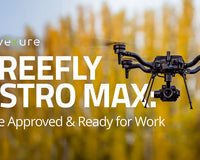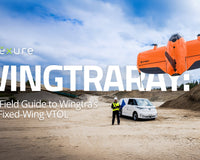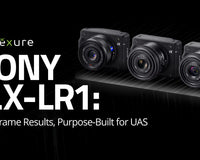Choosing the right EVO II drone for your application and mission set
As a commercial drone operator, you've got ten different options for your Autel EVO II platform.
That said, whether you're a consumer or enterprise operator, it's not always easy to understand what each has to offer.
After reading this article, you'll have a clear understanding of each model. And, you'll be able to decide which EVO II model works best for you and your UAS operation.
Throughout the article, we discuss some of the differentiating factors amongst the EVO II Series. But, if you’d like to jump to different sections that apply to you, just click on one of the links below.
JUMP TO:
Do you need Visual/RGB Imaging or Thermal?
Visual/RGB: EVO II (8K) vs. EVO II Pro (6K)
EVO II V1 vs. V2 - What’s the Difference?
Interchangeable Camera Payload System
EVO II Thermal Options: Dual, Dual R, 640T
EVO II Enterprise Model: Pro, 640T, Dual R
RTK with the EVO II Enterprise

Do you need Visual/RGB Imaging or Thermal?
First things first, the Autel EVO II product line includes solutions for consumer, prosumer, and enterprise needs.
Whether you're creating content or measuring heat patterns, there's a solution for you. So, it’s important to understand which models solely use visual/RGB imaging, and which include a thermal camera.
Different applications require different imaging needs. The first thing you need to do is assess your mission set.
Do you just need to collect visual/RGB images and video with your EVO II, or do you need to use and analyze thermal data?
For example, let's say you're flying at night. Visual imagery likely won't offer you much support. That means you'll need access to a thermal camera.
So, which EVO II model offers that solution? How about electro-optical/infra-red (EO/IR) dual-sensor payloads?
The table below breaks it down.
|
VISUAL/RGB |
VISUAL/RGB + THERMAL |
Visual/RGB Imaging: EVO II (8K) vs. EVO II Pro (6K)
Autel's visual-only EVO II lineup consists of the EVO II 8K and the EVO II Pro (6K).
So, how are they different, and which is better for you?
Without getting too technical, the 6K model is superior to the 8K model. That's due to the size of each's imaging sensor.
The 6K has a 1” CMOS sensor (Sony IMX383), while the 8K has a ½” CMOS sensor (Sony IMX586) - here's a technical breakdown of each.
Why does the sensor size matter?
The 1” sensor on the Pro model provides a greater light-gathering area, and also gives you the ability to adjust aperture -- the amount of light that passes through the camera -- from f/2.8 to f/11. Essentially, you'll have the ability to control your image across a wider range of lighting conditions.
The 1/2" sensor is what you'll commonly see on your camera phone. To get the most out of this sensor, you need good lighting. Without it, the sensor produces grainy, noisy footage and imagery.
In other words, you lose quality.
Now, both systems boast 40 minutes of flight time, 5.59 miles of HD transmission range, dynamic tracking, unmatched omni-directional obstacle avoidance, and 8GB of internal storage (expandable to 256GB). The only defining different is the camera system, as Autel uses the same aircraft for each.
So, if you're a professional photographer and/or videographer who needs image control, you'll need the EVO II 6K. Of course, you'll pay $300 more for the larger, higher-quality sensor.
But, if you're just in the market for a solid, reliable drone with a good camera that shoots in 8K and comes at a lower price point, then you'll do well with the EVO II 8K.
Base Units vs. Rugged Bundles
span class=" apple-converted-space>
Now that you know which drone system you prefer between the EVO II (8K) and EVO II Pro (6K), you'll want to pick the right package: Base Unit or Rugged Bundle.
With the Rugged Bundle, you get an extra Intelligent Battery, alone with a GPC Rugged Hard Case. The base unit only comes with one battery. It also doesn't include a case or bag.
Nearly 80% of users opt for the Rugged Bundle, as it costs less to buy the package than to get everything separately.
From a professional standpoint, the Rugged Bundle for the EVO II 6K also includes a 1-year subscription to Pix4Dreact - a 2D orthomosaic software designed specifically for public safety and emergency response.
When it comes to choosing between the two packages, you'll need to consider two things: will you need that extra battery, and how much protection do you need for your drone and its accessories?
Check out the different bundles here.
EVO II V1 vs. V2 - What’s the Difference?
In June 2021, Autel Robotics introduced version 2 (V2) of the EVO II aircraft, due to impacts on their supply chain caused by the global chip shortage.
With that announcement, they informed users that the first version (V1) would not work with V2 controllers, and vice versa. That resulted in the development of the V2 Autel Smart Controller.
Autel used all of that adversity to improve their product.
EVO II V2 units feature a dual-band transmission system, which provides increased transmission stability, enhancing the user experience. Aside from the transmission system, both versions are identical.
However, as previously mentioned, you can't pair an EVO II V1 to a V2 Smart Controller, or vice versa, since they run different transmission systems in their chipsets, making them incompatible with one another.
The good news: V1/V2 compatibility issues only affect radio-related components – airframe, remote controller, smart controller, and live deck.
Everything else -- batteries, accessories, camera payloads, etc.-- is cross-compatible.
Related Article: Autel Robotics EVO II Version 2 Announcement
Interchangeable Camera Payload System
Autel EVO II systems include various features for different types of remote pilots.
But, perhaps the most important (and unique) of which is its interchangeable camera payload system. In fact, it's the first foldable, sub-$3,000 drone system to offer swappable camera setups.
So, how does that benefit you as a user?
Let's say you own a drone service company, and you purchased the Autel EVO II Pro mode, which comes standard with a 6K 1” CMOS camera. One day, a potential customer reaches out and asks you to complete a solar panel inspection.
In order to detect anomalies in those panels, you need a thermal camera system. Instead of buying an all-new drone, with EVO II's interchangeable camera payload system, you just need to swap your 6K Pro camera with the 640T thermal camera.
And, with that, you've opened up a new world of opportunity for your business.
EVO II Thermal Options: Dual, Dual R, 640T
Since the EVO II series release in 2020, Autel has produced multiple thermal payloads.
Initially, the EVO II Dual, which features a FLIR Boson 640x512 30Hz camera, was the sole thermal offering.
Then, in Q3 2021, the company released two more thermal cameras: the Dual FLIR 640R and the 640T.
Related Article: Autel EVO II Dual 640 vs. EVO II Dual 640T
The 640R (FLIR Radiometric 640x512 30Hz) includes a radiometric feature, allowing EVO II to measure the temperature of a surface by interpreting the intensity of an infrared signal reaching the camera.
Essentially, it allows you to capture temperature data for every pixel of an image, and to save pictures for post-flight image analysis.
In contrast, the original 640 camera only displays temperature fields without the possibility of post-flight evaluation.
|
EVO II THERMAL CAMERA MODELS |
|
EVO II Dual = FLIR Boson 640 Thermal Core |
|
EVO II Dual R or 640R = FLIR Boson Radiometric 640 Thermal Core |
|
EVO II 640T = InfiRay Radiometric 640 Thermal Core |
Additionally, Autel released EVO II 640T to the North American market (only previously available outside of North America).
Like the Dual series, the EVO II 640T is a dual sensor camera payload. However, it doesn’t use a FLIR-manufactured thermal core
Instead, the EVO II 640T uses a thermal core made by Chinese manufacturer InfiRay.
All of the payloads provide the same resolution, but each comes at a different price point (640 - $8,399; 640R - $8,899; 640T - $5,700).
Though, we’ve found that most pilots see little to no variance in quality between the FLIR and InfiRay.
EVO II Enterprise Model: Pro, 640T, Dual R
In September 2021, Autel Robotics announced the EVO II Enterprise series, which expanded EVO II offerings and capabilities for commercial fleets serving professional missions.
While there’s only one EVO II Enterprise airframe, it’s offered in three models with different camera payloads: EVO II Pro Enterprise, EVO II 640T Enterprise, and EVO II Dual R Enterprise.
Compared to the original EVO II, the EVO II Enterprise airframe build includes sizable carbon fiber arms, larger motors, and bigger propellers.
These enhancements provide an additional 5-7 minutes of flight time, bringing the maximum flight time to 42 minutes.
Key Features of the EVO II Enterprise
- 5-7 minutes additional flight time (same battery)
- Add-on attachment modules (speaker, spotlight, strobe, RTK module)
- Carbon fiber arms which are lighter and more durable
- Larger motors and propellers
- Equipped with ADS-B receiver
- Comes standard with Autel 7.9” Smart Controller
Autel built the enhanced, long-lasting system to endure the harsh conditions that enterprise users may face during flights.
It’s truly an enterprise UAS in every sense of the word.
RTK with the EVO II Enterprise
As you’ve gathered by now, 2021 was a big year for Autel Robotics and the EVO II.
During the January 2021 CES, the company announced the release of the EVO II RTK module add-on,
The module leverages real-time kinematic (RTK) positioning accuracy of 1cm + 1ppm horizontally, and 1.5cm +1ppm vertically.
So, what is RTK on a drone?
We’ll sum it up in a few sentences, although it can easily have its own book.
Here’s a high-level overview:
Just about every drone includes a Global Positioning System (GPS). That system essentially provides your drone camera with basic positioning accuracy.
However, GPS does not tie back to the ground. Therefore, its accuracy in the vertical axis is not very good, and it’s typically not centimeter-accurate in the horizontal axis.
Multiple RTK workflows exist, but we’ll focus on Networked Transport of RTCM via Internet Protocol (NTRIP) for the EVO II Enterprise.
NTRIP enables an RTK GPS receiver, or rover, to access data from an RTK base station over the internet to achieve 1cm accuracies. Base and network stations have a known location and position on the ground that result in better accuracies in all three axes.
Oftentimes, states have free RTK network access that you can use in an NTRIP workflow.
RTK on the EVO II Enterprise eliminates the need for ground control points, allows you to make real-time corrections by using GPS positioning of your drone, provides better waypoint navigation, and assists with overall autonomy.
You’ll get real-time differential data, which makes it possible to obtain accurate coordinates of your designated target-point.
It’s a true game-changer, if you’re an EVO Enterprise II user.
Though, as with anything else, you’ll need to do your homework to decide on whether or not the RTK module is right for you.
Which EVO II Model Best Suits You?
From recreational users and professional videographers, to emergency responders and commercial inspectors, there’s an Autel EVO II solution for everyone.
Here’s a breakdown:
EVO II (8K Visual/RGB) – Best for hobby/recreational/enthusiasts wanting a good camera drone, but don’t want to pay a premium for a professional camera.
EVO II Pro (6K Visual/RGB) – Best for professional photographers/videographers wanting a strong 1” CMOS sensor camera with adjustable aperture. Also a strong option for commercial operators wanting a strong mapping drone for photogrammetry.
EVO II 640T (640 Radiometric Thermal by InfiRay + 8K Visual/RGB) – Best for public safety, police, fire, search & rescue missions that require thermal imaging along with thermal inspections.
EVO II Dual (replaced by Dual R) – Best for public safety, police, fire, search & rescue missions that require thermal imaging along with non-radiometric thermal inspections
EVO II Dual R (640 Radiometric Thermal by FLIR + 8K Visual/RGB) – Best for public safety, police, fire, search & rescue missions that require thermal imaging along with radiometric thermal inspections. Also compatible with FLIR Thermal Studio, previously referred to as FLIR Tools.
EVO II Enterprise (Available in Pro, 640T and Dual R) – Best for commercial applications needing additional flight time or use of the add-on modules (speaker, spotlight, strobe, RTK module). Often used in public safety, police, fire, search & rescue missions, commercial inspections, surveying and mapping applications requiring centimeter-level RTK accuracy.
If you’re still not sure which option works best for you and your operation, we’re here to help!
At Advexure, we don’t just sell drones; we provide solutions. We work with a variety of UAS operators across different industries, from police departments to powerline inspectors.
We understand that you don’t just need the drone, you need the result it provides.
Let’s find the right solution for you! To get started, just open the chat box, or contact us here.
We’re always here to help you with your UAS operation!
Also, check out our selection of Autel EVO II drones:










